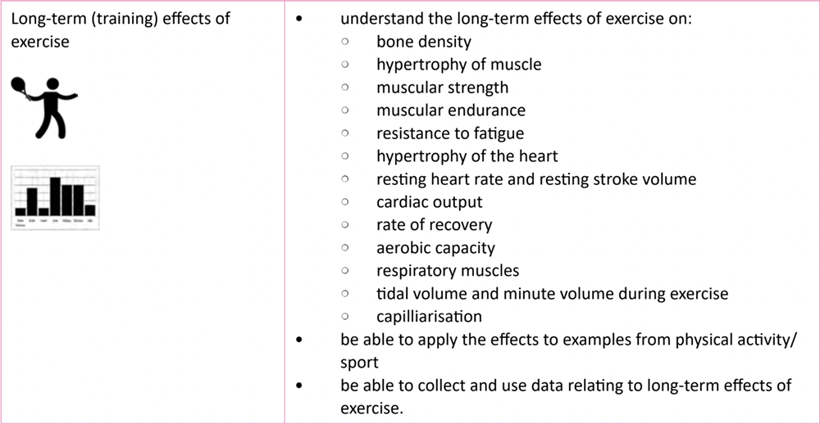PE teachers, stop teaching "to the spec"!
Welcome to the Changing Rooms blog. I am delighted you have chosen to visit and to have a read.
Now, let’s be candid… The title to this post is a bit clickbaity, right? I agree. I have written it like this to provoke a reaction or to cause a potential reader to think that maybe I am going to say something highly contentious. In reality, what you will find in this post is a very considered and analytical approach to what to teach in a PE classroom that is based on evidence and years and years of successful teaching and learning.
Let’s start at the beginning. You are likely to be a teacher of a PE qualification and that PE qualification will have a specification. This may be GCSE or BTEC or A level or VCERT but, regardless of the course, there is a clear guide to what the range of knowledge and skills that will be assessed will be. This is the specification.
Now, in many cases (possibly even the majority of cases) teachers are teaching “to the spec.” In order to be clear, I am going to define this concept:
So, this is sensible, right? Teachers are only required to teach what the specification states and, beyond or around this, we are asking the students to engage with material that “they don’t need to learn.” Well, no. This is not correct and it is this false assumption that I wish to challenge.
In order to challenge this false assumption, I am going to make three arguments. These arguments will progress in practicality order with the most practical and day-to-day argument being made first but all, in my opinion, should eliminate the assumption that teaching “to the spec” is an acceptable approach to classroom-based PE teaching.
I would also encourage you to feed back to me your thoughts on each argument using a blog comment below or, if you would rather not air your opinions in public, by direct email to james@theeverlearner.com. If this post prompts a reaction in you, please do send that to me and I will engage with your feedback and respond to you personally. Feedback is always gratefully received and I thank you for your time in writing to me.
Argument 1: It is the core duty of a PE teacher to teach to the fullest breadth of a specification mark scheme as a minimum
This point is relatively self-explanatory. If we tweak our stance, we become far closer to an ideal model. I am arguing that you and I have a duty to teach every word, concept, principle and application that has appeared or might appear on a mark scheme for an exam for your qualification.
The thing is, specifications are simply theory skeletons and, around these theory skeletons are built layers and layers of additional understanding, application and evaluation.
Let’s take an example from OCR GCSE PE. The specification states the following for the long-term effects of training:

But the key factor here is being able to understand and apply these effects including the use of data. Therefore, if we were to analyse every single mark scheme since 2018 for this section, we would find the following range of relevant material to teach:
Now, if we extract this material from the mark schemes, we are able to produce a base requirement for our teaching as follows:
|
Understand the long-term effects of exercise on |
General |
Less likely to have disease |
|
Decreased chance of premature death |
||
|
Moderate intensity is best/low intensity is best |
||
|
Control amount of body fat |
||
|
Bone density |
Increased bone density |
|
|
Stronger bone matrix |
||
|
Less brittle bones |
||
|
Decreased chance of osteoporosis |
||
|
Hypertrophy of muscle |
Increase in muscle size/Increase in cross-sectional area |
|
|
Increase in strength |
||
|
Muscular strength |
Increase in strength of muscle |
|
|
Increase in muscle tone |
||
|
Increase in power |
||
|
Stronger ligaments |
||
|
Increase in tendon strength |
||
|
Muscular endurance |
Increase in muscular endurance |
|
|
Decrease in fatigue |
||
|
Go for longer |
||
|
Resistance to fatigue |
Increased resistance to fatigue |
|
|
Increased rate of removal of lactic acid |
||
|
Increased tolerance to lactic acid |
||
|
Hypertrophy of the heart |
Increased size of the heart |
|
|
The heart becomes stronger/stronger contractions |
||
|
Resting heart rate |
Decreased resting heart rate |
|
|
Bradycardia |
||
|
Resting stroke volume |
Increased resting stroke volume |
|
|
Cardiac output |
Increase in maximum cardiac output |
|
|
Rate of recovery |
Increased recovery rate |
|
|
Increased rate of removal of lactic acid |
||
|
Reduced recovery time |
||
|
Recovery will be longer if more lactic acid has built up/Lactic acid slows down recovery |
||
|
Aerobic capacity |
Increased tolerance to lactic acid |
|
|
Delayed OBLA |
||
|
Higher anaerobic threshold |
||
|
Keep playing for longer/keep playing harder/more likely to last 90 minutes |
||
|
Respiratory muscles |
Increased strength of respiratory muscles/Stronger diaphragm/Stronger intercostals |
|
|
Increased efficiency to take in oxygen |
||
|
Increased surface area of alveoli because more alveoli are reached |
||
|
Tidal volume during exercise |
Increase in tidal volume/Increase in TV/Increase in resting tidal volume |
|
|
Minute volume during exercise |
Increase in minute volume/Increase in VE |
|
|
Increase in maximum pulmonary ventilation/Increase in total amount of air into the lungs |
||
|
Capillarisation |
Increase in the number of capillaries |
|
|
Capillarisation at the muscles |
||
|
Capillarisation at the heart |
||
|
Capillarisation at the lung/Increased capillary density around alveoli |
And we also need to recognise that this is not the end of the story. We still need to be able to apply this understanding to a range of different contexts AND, where relevant, evaluate the concepts or analyse them using data.
Finally, as comprehensive as the list above may appear to you, we also need to recognise that this content requirement merely represents what has been required previously. We still need to be able to “teach for the future mark schemes” and to ensure that our learners have a knowledge base which is robust enough to be applied in unique ways in future exams.
Therefore, all in all, “teaching to the spec” is simply not going to cause students to be able to perform well in exams. For this reason, I repeat:
It is the core duty of a PE teacher to teach to the fullest breadth of a specification mark scheme as a minimum.
To finish this section off, I want to draw your attention to the word “minimum” in the statement above. I want you to recognise that teaching to the depth and breadth that I am advocating for is not aspirational. Rather, it is the base requirement of teachers and every PE teacher needs to be achieving this. Otherwise, we are simply causing our students to lack the knowledge and skill base to access a mark scheme for our course.
Argument 2: The specification is simply a designated list of what will be assessed. It is not designed to be a teaching guide
I want to be very clear here and, yes, I accept that what I write in the next statement is “strong”: In amongst the worst classroom PE-teaching episodes I have witnessed, I have seen many teachers “teaching up to the spec.” You already know that I believe that teachers should be teaching to the breadth of a mark scheme as an absolute minimum but I want to take this further.
One feature of a range of low-quality PE lessons that I have witnessed, the teacher has missed numerous opportunities to educate broadly and deeply because “it’s not on the spec.”
Test Prepper < Teacher < Educator
Let’s step back and consider this. What is an "educator"? What is a "teacher"? What is a "test prepper"? I encourage you, rhetorically, to consider what your answers to these questions would be. I believe that "test preppers" need to aspire to be teachers and that teachers need to aspire to be educators and that education can be defined as follows:
Now, this means that I, as an educator, have a responsibility to the students in my care to achieve this goal. Whilst I never go rogue and teach irrelevant content, I do allow the space for students to explore concepts and ideas that are most relevant to them as individuals. For example, if I am working with an OCR A-level PE group (as I am currently) and I have a student in my group who is an elite swimmer and is aiming to achieve the next round of podium potential awards, I will consider discussing achievement motivation with them even though this is not on the OCR specification.
Take a look at the specification area on motivation:

This is all the specification encourages me to teach them and even if I expand this out as I did within argument 1, I only end up with the following base learning:
|
Individual differences: Motivation |
Definition of intrinsic motivation |
Internal drive to participate |
|
Wanting to take part for enjoyment/fun |
||
|
Internal mechanisms which arouse and direct behaviour |
||
|
Definition of extrinsic motivation |
External drive to participate |
|
|
Taking part for rewards/money/recognition |
||
|
Uses of intrinsic motivation |
Make learning and movement experiences enjoyable |
|
|
Explain (cognitive) the value of what is being done |
||
|
Be cautious to overly reward/incentivise behaviour as this will encourage a lack of intrinsic value |
||
|
Recognise and reinforce intrinsic motivation including fun |
||
|
Effects of intrinsic motivation |
Perseverance |
|
|
Persistence |
||
|
Positive attitude |
||
|
Positive effect on others |
||
|
Lifetime participation |
||
|
Uses of extrinsic motivation |
Goal setting with rewards |
|
|
Badges, points, trophies |
||
|
Effects of extrinsic motivation |
Increases drive towards a goal |
|
|
Increases confidence once achieved |
||
|
Provides status |
||
|
Often overused |
||
|
If overused, can diminish intrinsic motivation |
But, even with this amplification of the core material, I may believe that my student would benefit from a knowledge of McLelland and Atkinson’s theory that all individuals have a balance between how they are driven by avoiding failure (Need to Avoid Failure) and by achieving success (Need to Achieve - NAch).

Whilst this learner does not “need to learn” this material to pass their exam, the learning could be advantageous to this young person on a human level. Furthermore, their continued success in their sport makes them a rounded person and someone likely to study hard and my sharing of these additional ideas may resource them further. I am deeply proud to tell you that, even in the most informal ways, I take 100% of these opportunities to educate broadly and deeply regardless of what a specification includes or doesn't. I tend to take relatively little time on these points and they are often individualised for a specific student but they are part of me and they are part of my classroom and I, unless banished from teaching forever, will always do this.
Now, one’s subject knowledge will affect one’s capacity to take these opportunities. Therefore, I urge all teachers to be hungry to continuously update and broaden their subject knowledge over time.
Argument 3: No human being has the right to tell another what they need to learn or not
This argument is far more philosophical than the previous two, which are both (in my opinion) practical ways to think about teaching. I want to argue now that no-one - teacher or otherwise - has the right to tell anyone else what they need to learn or don’t.
You will not be surprised to read that one of my outright bugbears is the phrase: “Don’t worry, you don’t need to learn that.” Normally, this phrase is uttered in the following circumstances:
- A student has asked a teacher a question but the answer to that question is considered by the teacher to be off-spec.
- Specifically, a student has asked a question that is from the next level of PE study.
- Specifically, a student has asked a question which relates to a model of learning from biology/chemistry/food science that is taught “differently” in PE.
- One educator (let’s say within a department) has taught students an idea and another educator has come across this idea when teaching the same students.
- Students have been guided by one educator who has taught to the fullest extent of the mark scheme (argument 1) and another teacher is teaching up to the spec.
So, let’s make this clear: You, I or any teacher does not have the right to tell a student “You don’t need to learn that.” Writing philosophically, students may choose to learn anything they wish and our role is to guide and support them. Now, I am unlikely to give classroom time to a more abstract idea or low-impact concept but I will never - and I really mean never - tell a student not to learn something. Rather, I may use phrasing like this:
- Great question and, if there’s time left at the end, I’ll answer it for you. But, for now, I want us to stay focussed on…
- The answer is… but I want you to be aware that you won’t be examined on that.
- Fascinating question. I have some resources on that which I can share with you and you can look at it in your own time.
And my personal favourites:
- Fascinating. You’re right. In biology it is stated that… but in PE we learn the same thing in this way… What do you think?
- Right, stop what you’re doing, class. Student X has just asked me a question but it relates to A level rather than GCSE PE (say). For those of you interested, I’ll teach this for a few moments over here (part of the room, say). Just be aware this won’t be on your exam this summer and if you’re up against it to get your tasks mastered, you might want to stay with that.
This list is not exhaustive, of course, and you may find your own ways to answer this but notice what I am doing with all of those responses. I am both:
- honouring the student’s right to be intrigued by or learn something they are interested in; and
- remaining focussed on the job in hand, which is students mastering the fullest breadth of our courses as a minimum.
I believe that this is exemplary practice and I urge you to do likewise.
Thank you for reaching the end of the post. I hope you have found it useful. I would value your feedback and comments and I encourage you to make them below.
Have a lovely day.
%20Text%20(Violet).png)


